Synthesis:
All learning approaches point toward imparting relevant content . But scenario- based learning possesses a distinct advantage ,tremendous value and the power to alter views, practices , accepted norms and even culture . Find out the 10 reasons why scenarios work and how it can empower your eLearning programs.
-------------------------------------------------------------------------------------
Imagine that you would like to ask your boss for a well-deserved raise. How will you go about it? Do you have what it takes to successfully negotiate this?
Click on the image to play out this scenario to see how it can help you.
(Produced by Michael Gibson)
In a number of instances, I hear complaints that scenarios are challenging to produce – difficult to a point. However, for those who realize the incredible value it adds to their eLearning programs , this serves as a stimulus to press on and explore various cost-effective formats to achieve their goal.
At the onset, it is best to recognize that learners approach online learning quite differently from other formats. They can click away with their mouse or simply drop the study altogether. They are in almost total control of their learning. So how do you compel or engage them to learn?
Answer: put them on the spot. Thrust them into situations that require them to think, act and decide. Moreover, provide your learners with the opportunities to enact and respond to real-life scenarios. Simulate actual situations that deal with day-to-day experiences. Use stories to make their learning experience real, alive, living and enthralling.
Here I list the 10 reasons why leveraging Micro Scenarios and Interactive Stories truly works:
1. Learners’ participation is harnessed through story and experience sharing
Each of us carry stories within us. Micro Scenarios and Story interaction coaxes learners to share their own real-life accounts, listen to others and learn from each other.
(See related blog)
2. It boosts content absorption and retention in participants
People learn best when they can relate information to real-life situations. They do not remember facts easily. Stories help learners understand and recall the concepts behind the learning
(See related blog)
3. Learners get immersed in engaging real-life simulations for better job performance.
Replicating real-life scenarios help the learners recognize valuable nuggets of content that they can readily apply to actual job performance.
4. It challenges learners’ cognitive skills, evaluation and decision-making processes
Adding tension to eLearning stories focuses the learners’ attention on response and reaction. in the use of stories, tension serves as a lever, fulcrum or a tourniquet that can be tightened to get the desired action or reaction from learners. People tend to respond to a stimulus that raises their tension level, be it positive or negative. And we can take advantage of this basic human instinct.
(See related blog)
5. Un-learning perceptions, beliefs, accepted norms, practices and methods that bring about individual and organizational change.
“Stories help us unlearn and replace inadequate or outdated mental models by appealing to us at an emotional or intuitive level instead.” (excerpt from the writing of Deborah Sole, Learning Innovations Laboratories, Harvard Graduate School of Education)
6. Promoting new ideas or concepts and make them easily acceptable to learners
“If we are to achieve results never before accomplished, we must employ methods never before attempted.” Sir Francis Bacon
The story-based approach affords you a highly engaging and compelling method of presenting fresh, novel, innovative ideas that eases your learners into your desired mode of acceptance.
7. Learners embark on a journey through scenarios to synthesize complex ideas and skills
It is about recognizing patterns from a series of choices leading to the discovery of the ideas.
(See related blog)
8. Sharpen learners’ ability to identify high-impact ideas immediately applicable to their jobs.
Instant learning happens as a quick loop of experience consisting of an event, feedback and discovery. In the rapidly changing work environment where the demand for new knowledge and skill is fast and in constant flux, we have opportunities to use the instant experience loop. How do we do that? We replicate the instant experience loop by sharing stories and the realities of life.
(See related blog)
9. Converting boring, technical content into easily understood, user-friendly case scenarios of actual real-life work situations.
Using the case and scenario techniques enhances the effectiveness and efficiency of the learning process. Technical content becomes more engaging and learners become skilled and are able to rapidly apply knowledge in the real world or work.
(See related blog)
Here listed are some of the ways to tell stories in eLearning. Find out how you can use them.
(See related blog)
10. Turning boring, static and stale learning objectives from mere documents into valuable tools - stories that spin off the discovery of more hidden stories.
The key benefit of stating a learning goal as a story is that it allows us the opportunity to continue using the story to deliver the rest of the lesson.
(See related blog)
Conclusion
Everyone has a story to tell. People listen to them. Engage your learners. Hold their attention. Encourage interactivity. Promote sharing of real-life stories. Achieve your learning objectives with Micro Scenarios and Interactive Stories. Push your learners to the brink of a new learning threshold – content discoveries through stories.
Rediscover the power of stories that are applied to eLearning designs to provide a highly creative way for eLearning professionals like you to bring learning content to life.
Related Blogs
The Battle of Stories – Instructional Design Approach
Adding Tension to eLearning Stories to Engage Learners
How to instantly grab e-learners attention!
How to Embed Learning Goals in Stories
Ray Jimenez, PhD
3Minute Worlds - Learning Community Social Learning, Work and Performance3Minute eLearning Games
"Helping Learners Learn Their Way"












